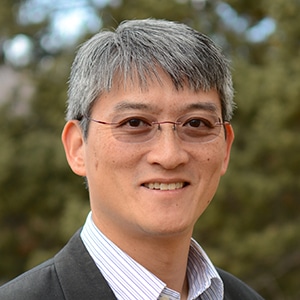David T. Wu
Professor, Chemistry
Professor (By Courtesy), Chemical and Biological Engineering
 Technological and scientific advances in complex materials present many exciting challenges for the theoretician working in chemical engineering or chemistry. More than ever before, fundamental knowledge and control of microstructure can translate directly into materials with novel and superior properties. I believe a combination of analytical theory and computational research can be a highly effective way to acquire an understanding of these diverse materials. My research approach draws widely from both statistical mechanics and modern computational methods and is concerned with a broad range of materials. I am currently pursuing research in four areas:
Technological and scientific advances in complex materials present many exciting challenges for the theoretician working in chemical engineering or chemistry. More than ever before, fundamental knowledge and control of microstructure can translate directly into materials with novel and superior properties. I believe a combination of analytical theory and computational research can be a highly effective way to acquire an understanding of these diverse materials. My research approach draws widely from both statistical mechanics and modern computational methods and is concerned with a broad range of materials. I am currently pursuing research in four areas:
1. Conformational Effects in Conducting Polymers. I am developing theoretical models for understanding the interplay of geometrical surface and polymer/polymer effects with conformational and conductive properties.
2. Statistical Mechanics of Powders. I am developing statistical mechanical approaches to understand the role of particle morphology, packing, and hysteresis in determining bulk properties.
3. Algorithms for Direct Simulation of Solid-Phase Coexistence. I am developing general algorithms that are expected to be of extensive use for solid phase coexistence.
4. Viral Morphogenesis: Programmed Self-Assembly. My research, involving theory and simulation, is aimed at elucidating the physical and mechanical role of subunit polymorphology in determining the final assembled structure.
Contact
Labs and Research Centers
Education
- AB – Harvard University, Department of Chemistry
- PhD – University of California at Berkeley, Department of Chemistry
- Post-Doctoral Study – Cambridge University, Cavendish Laboratory and University of California at Santa Barbara, Department of Chemical Engineering and Materials Research Laboratory
Research Areas
Technological and scientific advances in complex materials present many exciting challenges for the theoretician working in chemical engineering or chemistry. More than ever before, fundamental knowledge and control of microstructure can translate directly into materials with novel and superior properties. I believe a combination of analytical theory and computational research can be a highly effective way to acquire an understanding of these diverse materials. My research approach draws widely from both statistical mechanics and modern computational methods and is concerned with a broad range of materials. I am currently pursuing research in four areas:
- Conformational Effects in Conducting Polymers. I am developing theoretical models for understanding the interplay of geometrical surface and polymer/polymer effects with conformational and conductive properties.
- Statistical Mechanics of Powders. I am developing statistical mechanical approaches to understand the role of particle morphology, packing, and hysteresis in determining bulk properties.
- Algorithms for Direct Simulation of Solid-Phase Coexistence. I am developing general algorithms that are expected to be of extensive use for solid phase coexistence.
- Viral Morphogenesis: Programmed Self-Assembly. My research, involving theory and simulation, is aimed at elucidating the physical and mechanical role of subunit polymorphology in determining the final assembled structure.
